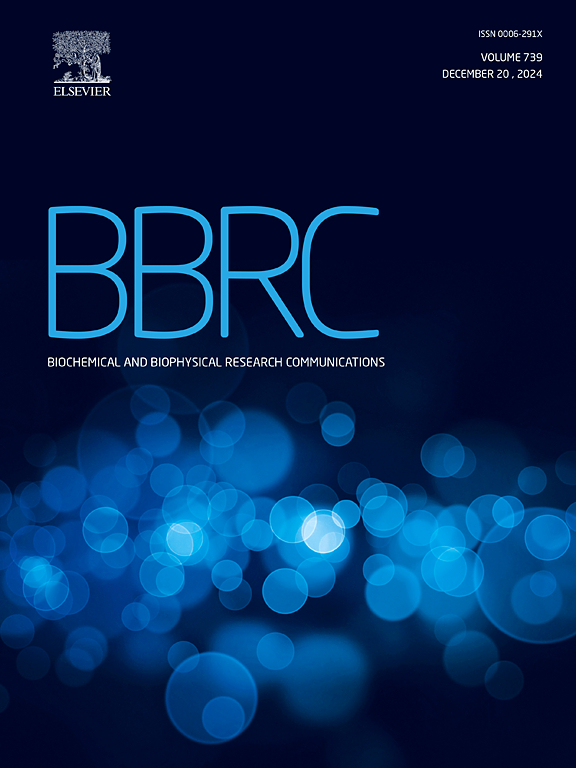1 型肌营养不良症细胞模型中 MBNL1 的 CUG 重复 RNA 依赖性蛋白酶体降解
IF 2.5
3区 生物学
Q3 BIOCHEMISTRY & MOLECULAR BIOLOGY
Biochemical and biophysical research communications
Pub Date : 2024-09-21
DOI:10.1016/j.bbrc.2024.150729
引用次数: 0
摘要
肌营养不良症 1 型(DM1)是由 DMPK 中的非编码 CTG 重复扩增引起的。含 CUG 重复的转录本将剪接调节因子 MBNL1 封闭在核 RNA 病灶中,导致许多基因剪接异常。虽然 MBNL1 的错误定位是 DM1 发病机制中的一个因果事件,但 CUG 重复 RNA 对 MBNL1 蛋白水平的影响仍不清楚。通过使用 DM1 模型细胞系,我们发现 CUG 重复 RNA 会导致 MBNL1 蛋白水平显著下降,但不会导致 mRNA 水平显著下降。由于 CUG 重复并没有降低 MBNL1 的翻译,我们对蛋白质降解途径进行了研究。虽然自噬相关试剂诱导的变化不大,但蛋白酶体抑制剂在 CUG 重复表达条件下部分恢复了 MBNL1 蛋白表达水平,并诱导剪接失调发生轻微但显著的逆转。在多泛素化蛋白部分检测到了 MBNL1,但未检测到 MBNL1 的多泛素化。此外,抑制泛素激活酶 E1 并未增加 MBNL1 的水平,这表明 MBNL1 是多泛素独立蛋白酶体降解的底物。这些结果表明,CUG-重复诱导的蛋白酶体降解是导致 MBNL1 功能下降的部分原因。本文章由计算机程序翻译,如有差异,请以英文原文为准。
CUG repeat RNA-dependent proteasomal degradation of MBNL1 in a cellular model of myotonic dystrophy type 1
Myotonic dystrophy type 1 (DM1) is caused by the expansion of a non-coding CTG repeat in DMPK. CUG-repeat-containing transcripts sequester the splicing regulator MBNL1 into nuclear RNA foci, causing aberrant splicing of many genes. Although the mislocalization of MBNL1 represents a causal event in DM1 pathogenesis, the effect of CUG repeat RNA on the protein level of MBNL1 remains unclear. Using a DM1 model cell line, we found that CUG repeat RNA caused a significant decrease in the protein, but not mRNA levels, of MBNL1. As CUG repeats did not decrease MBNL1 translation, we investigated protein degradation pathways. Although autophagy-related reagents induced little change, proteasome inhibitors partially recovered MBNL1 protein expression levels under conditions of CUG repeat expression and induced a slight, but significant, reversal of splicing dysregulation. MBNL1 was detected in the polyubiquitinated protein fraction, but MBNL1 polyubiquitination was not detected. Moreover, inhibition of the ubiquitin-activating enzyme E1 did not increase MBNL1 levels, suggesting that MBNL1 is a substrate of polyubiquitin-independent proteasomal degradation. These results suggest that CUG-repeat-induced proteasomal degradation partially contributes to the functional decline of MBNL1.
求助全文
通过发布文献求助,成功后即可免费获取论文全文。
去求助
来源期刊
CiteScore
6.10
自引率
0.00%
发文量
1400
审稿时长
14 days
期刊介绍:
Biochemical and Biophysical Research Communications is the premier international journal devoted to the very rapid dissemination of timely and significant experimental results in diverse fields of biological research. The development of the "Breakthroughs and Views" section brings the minireview format to the journal, and issues often contain collections of special interest manuscripts. BBRC is published weekly (52 issues/year).Research Areas now include: Biochemistry; biophysics; cell biology; developmental biology; immunology
; molecular biology; neurobiology; plant biology and proteomics

 求助内容:
求助内容: 应助结果提醒方式:
应助结果提醒方式:


